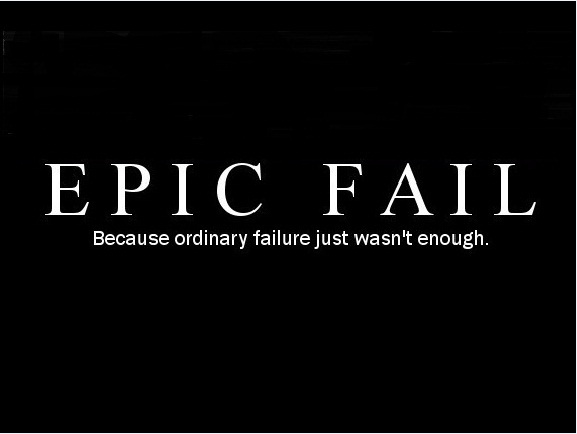Laura Overton gives us her top anti-tips on how to ensure that you make the least of your elearning investments – follow them at your peril!
1. Take advantage of preconceived ideas (mandate it and make it boring)
It is important to remember that most people’s experience of technology in learning is one of complete boredom as a result of mandated compliance training with no interaction, lots and lots of words and the obligatory test at the end. Whatever you do – make sure that you don’t break the mould – if you want your project to fail, it’s best to force your staff through the dullest page turners you can find. Leveraging preconceived ideas and building on negative experiences will really help you disengage your audience – a first priority for failure.
2. Isolate your learner
This links to the point above, people naturally expect to do elearning in a self-paced mode with no contact with the outside world. To encourage ongoing resistance, it is best not to harness some of the connectivity that the web now offers. I know that most people (not just Gen Yers!) are using the web to connect with each other to exchange opinions and answer questions in many areas of work and home life but there is NO reason to believe that this behaviour will flow into learning at all. Don’t be tempted to try it (despite the range of free tools out there) as this will open up a whole can of worms as staff interact with each other and experts in a way that might really encourage engagement.
3. Keep your focus on your priorities – the technology
You can encourage failure by completely ignoring business needs and priorities. If you are going to use technology in learning, it is best to jump straight in and come up with something the technology can do rather than something the business needs. After all, it is exciting to hop onto the bandwagon of the latest trends and there is an added benefit that your solutions are much more likely to fail if you take your eye off the business drivers.
4. Put elearning design in the hands of the right people
Ideally handing everything over to internal subject matter experts is best here – they are guaranteed to pump your content full of words and dull detail! As learning and development professionals, it is best to keep your own ability to design interactive, engaging learning experiences that provide opportunities for practical application in the workplace to the classroom. This division of labour helps achieve your goal on two fronts – firstly you keep your elearning programmes boring (see tip 1) and secondly you can ensure there is always a better alternative to using technology that learners are bound to prefer.
5. Don’t engaging stakeholders too soon
Whenever you produce an elearning solution, it is best to unveil it to your organisation as a fait accompli. Don’t ask stakeholders up front about what they need the programme to do or what success might look like for them. Do not be tempted to engage staff in the design phases of your solution working with you on prototypes as the programme is developed. Do not pilot the solution with a group of users and their managers. However if you have been tempted to do this, all is not lost, just make sure that you ignore all the feedback they have provided as that should keep you on track to fail.
6. Focus on cutting cost
Once your programme is in place, you might feel the need to start talking about it (although ideally we recommend that you have no communication plan around your initiative). So If you want your project to fail, trip up on its first outing, then a strong emphasis on cutting costs will do the trick. Staff who have to go through the learning will really hate this and think that think that you are automatically short-changing them and depriving them of ‘real training’. However if you are talking to finance directors, the opposite is true – you should avoid mentioning efficiencies at all cost as they love it! Instead why not try engaging them with evidence of course completion instead – always a winner!
7. Make sure that the solution cannot scale
If you fail to deliver on the tips above, there might be a real danger that your program will be successful and possibly even generate interest for more. You can nip this in the bud by making sure that your solution can’t scale to meet demand. One way to do this is to ensure that your first forays into using technology are heavily customised – that way they can’t be easily adapted. Another way is to refuse to contemplate success – if you don’t think that anyone else will be interested , you won’t be tempted to plan for it!
Be part of the research
This year, many organisations are under even more pressure to deliver more learning with fewer resources and need their learning technologies to work even harder. If you are in a position where you need your investment to be more successful in delivering real impact in your workplace, then we also have a tip for you as well. Why not take part in the 2010 TM Benchmark study which launched last week. 800 organisations have already been through it and as a result we’ve been able to independently analyse what really influences success. Participants will receive a free personalised benchmark with practical advice to help them accelerate the benefits of learning technologies in their organisation.
TZ members can take part here and we’ll report back on the findings later this year.
Laura Overton is the managing director of Towards Maturity, an independent not-for-profit organisation that provides free research and case studies to help organisations improve the impact of learning technologies in the workplace.
Have you joined the eLearning Network here on TZ?
Laura Overton gives us her top anti-tips on how to ensure that you make the least of your elearning investments - follow them at your peril!
1. Take advantage of preconceived ideas (mandate it and make it boring)
It is important to remember that most people’s experience of technology in learning is one of complete boredom as a result of mandated compliance training with no interaction, lots and lots of words and the obligatory test at the end. Whatever you do - make sure that you don’t break the mould – if you want your project to fail, it's best to force your staff through the dullest page turners you can find. Leveraging preconceived ideas and building on negative experiences will really help you disengage your audience – a first priority for failure.
2. Isolate your learner
This links to the point above, people naturally expect to do elearning in a self-paced mode with no contact with the outside world. To encourage ongoing resistance, it is best not to harness some of the connectivity that the web now offers. I know that most people (not just Gen Yers!) are using the web to connect with each other to exchange opinions and answer questions in many areas of work and home life but there is NO reason to believe that this behaviour will flow into learning at all. Don’t be tempted to try it (despite the range of free tools out there) as this will open up a whole can of worms as staff interact with each other and experts in a way that might really encourage engagement.
3. Keep your focus on your priorities – the technology
You can encourage failure by completely ignoring business needs and priorities. If you are going to use technology in learning, it is best to jump straight in and come up with something the technology can do rather than something the business needs. After all, it is exciting to hop onto the bandwagon of the latest trends and there is an added benefit that your solutions are much more likely to fail if you take your eye off the business drivers.
4. Put elearning design in the hands of the right people
Ideally handing everything over to internal subject matter experts is best here – they are guaranteed to pump your content full of words and dull detail! As learning and development professionals, it is best to keep your own ability to design interactive, engaging learning experiences that provide opportunities for practical application in the workplace to the classroom. This division of labour helps achieve your goal on two fronts – firstly you keep your elearning programmes boring (see tip 1) and secondly you can ensure there is always a better alternative to using technology that learners are bound to prefer.
5. Don’t engaging stakeholders too soon
Whenever you produce an elearning solution, it is best to unveil it to your organisation as a fait accompli. Don’t ask stakeholders up front about what they need the programme to do or what success might look like for them. Do not be tempted to engage staff in the design phases of your solution working with you on prototypes as the programme is developed. Do not pilot the solution with a group of users and their managers. However if you have been tempted to do this, all is not lost, just make sure that you ignore all the feedback they have provided as that should keep you on track to fail.
6. Focus on cutting cost
Once your programme is in place, you might feel the need to start talking about it (although ideally we recommend that you have no communication plan around your initiative). So If you want your project to fail, trip up on its first outing, then a strong emphasis on cutting costs will do the trick. Staff who have to go through the learning will really hate this and think that think that you are automatically short-changing them and depriving them of ‘real training’. However if you are talking to finance directors, the opposite is true – you should avoid mentioning efficiencies at all cost as they love it! Instead why not try engaging them with evidence of course completion instead - always a winner!
7. Make sure that the solution cannot scale
If you fail to deliver on the tips above, there might be a real danger that your program will be successful and possibly even generate interest for more. You can nip this in the bud by making sure that your solution can’t scale to meet demand. One way to do this is to ensure that your first forays into using technology are heavily customised – that way they can’t be easily adapted. Another way is to refuse to contemplate success – if you don’t think that anyone else will be interested , you won’t be tempted to plan for it!
Be part of the research
This year, many organisations are under even more pressure to deliver more learning with fewer resources and need their learning technologies to work even harder. If you are in a position where you need your investment to be more successful in delivering real impact in your workplace, then we also have a tip for you as well. Why not take part in the 2010 TM Benchmark study which launched last week. 800 organisations have already been through it and as a result we’ve been able to independently analyse what really influences success. Participants will receive a free personalised benchmark with practical advice to help them accelerate the benefits of learning technologies in their organisation.
TZ members can take part here and we'll report back on the findings later this year.
Laura Overton is the managing director of Towards Maturity, an independent not-for-profit organisation that provides free research and case studies to help organisations improve the impact of learning technologies in the workplace.
Have you joined the eLearning Network here on TZ?








